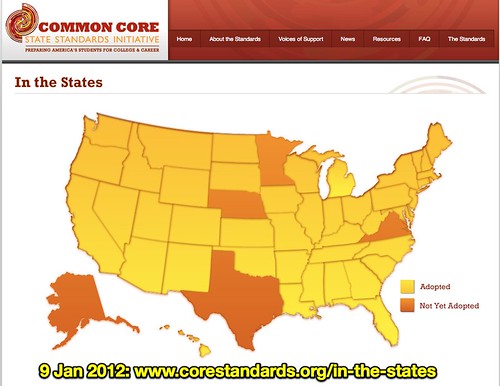These are my notes from Karen Robertson‘s presentation on January 9, 2012, for the school board of Yukon Public Schools providing an introduction to the Common Core State Standards. Karen is the Executive Director of Curriculum and Assessment at Yukon Public Schools in Oklahoma.
Common Core state standards initiative
– state-led and developed common core standards for K12 in ELA and math
– initiative led by Council of Chief State School Officers (CCSSO) and National Governors Association (NGA)
What are educational standards and why do they matter?
– standards define what the outcomes will be for our students?
– the create shared understanding for our student of what they need to know and be able to do at each grade level when they leave our schools
States were in the driver’s seat
– federal government did not develop the standards or require adoption
Why do we need common standards?
– disparate standards across states
– today’s jobs require different skills
– global competition
– for many young people, a high school degree isn’t preparing them for college or a good job
Why is this important for all students, teachers and parents?
– prepares students with knowledge and skills they need to succeed in college and work
– ensures consistent expectations regardless of student zip codes
– provide clear, focused guideposts
– offers economies of scale (will drive down costs for testing, we have several consortiums, we are in the Park Consortium, all states in that consortium will be using the same bank of questions to measure the outcomes)
In part this was a response to criticism that schools (not necessarily Yukon PS, however) were not preparing students adequately/well for college/work
Features of standards
– aligned with college and work expectations
– forced and coherent
– include rigorous content and application of knowledge through high-order skills
– build upon strengths and lessons of current state standards
– based on evidence and research
– internationally benchmarked
– should be read to allow the widest possible range of students to participate fully
Aligned with college and work expectations
Standards development process
– college and career readiness standards for ELA and Math developed in summer of 2009
– based on college and career readiness standards, K12 standards for each grade were developed
– continual input throughout process from states, educators, business and higher education leaders
– public commit period received almost 10,000 comments
– final standards were released in June 2010
Map of Common Core State Standards Adoption
Applications for English language learners
– learn academic content WHILE learning English
Design and organization
– intro have description of capacities of a literate student (e.g. demonstrate independence, come to understand other perspectives and cultures)
3 main sections
– K-5 cross-disciplinary
– 6-12 ELA
– 6-12 literacy
ELA Key advances
Reading
– balance of literature and informational texts
– text complexity
Writing
– emphasis on argument and informative/explanatory writing
– writing about sources
Standards for reading and writing in history / social studies, science and technical subjects
– will complement rather than replace existing content standards
Standards for mathematical practice
– carry across all grade levels to address ‘gaps’
– describe habits of mind of a mathematically expert studetn
Standards for math content
– K-8 standards presented by grade level
– high school standard presented by conceptual theme (some states call math courses math 1, math 2, math 3, etc)
Math key advances
– focus in early grades on numbers (arithmetic and operations) to build a solid foundation in math (good change, we’ve been teaching too many objectives to young children, too early)
– evened out pace across the grades
– focus on USING math and solving complex problems, similar to what we should see in the real world in high school
– emphasis on problem solving and communication
Yukon’s Plan
– implementation plan developed in 2010-2011
– building knowledge
– side by sides to current standards (PASS skills)
– deconstructing the standards
– ongoing PD for faculty and staff
CCSS should be fully implemented in our classrooms no later than 2013-2014
State department of education has developed the REACH Network
– Deer Creek is our lead, we’ve had 1 meeting so far
– they shared information from the SDE in the ‘toolkit’ they received
(no questions from the board)
If you enjoyed this post and found it useful, subscribe to Wes’ free newsletter. Check out Wes’ video tutorial library, “Playing with Media.” Information about more ways to learn with Dr. Wesley Fryer are available on wesfryer.com/after.
On this day..
- Embed Twitter Widget in Dot Net Nuke (DNN) Website – 2015
- Disadvantages of Openly Sharing Media – 2014
- Yukon Students Learning Computer Programming with Scratch – 2013
- An Iterative Google Search (with advanced options) solves a MS Word File Saving Problem – 2012
- Learning about Glass Blowing in Santa Fe, New Mexico (videos) – 2011
- Good Memories from Denton and UNT – 2011
- Virtual DNA Fingerprinting Lab (1 to 1 Learning in Yarmouth, Maine) – 2011
- Brainstorm & Find Available Websites with DomainStorm – 2011
- Getting Creative with Windows Live Movie Maker on a Netbook – 2010
- Recovering lost iTunes Song Purchases (maybe) and iTunes Library Backups – 2010

